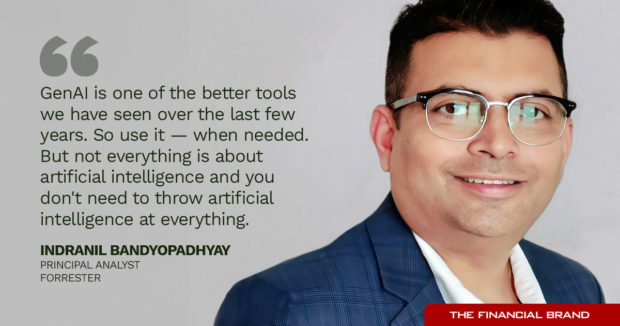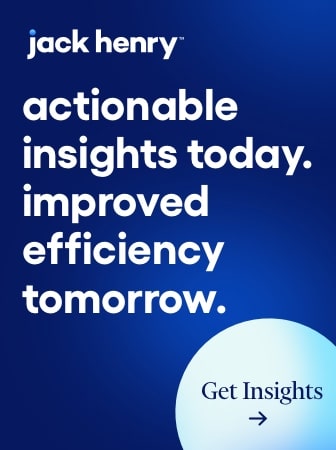Why is your bank in business?
It’s not a trick question. Why does your bank exist today?
When GenAI exploded on the scene, a good part of the industry took its eye off the answer to that question, says Indranil Bandyopadhyay.
Now a principal analyst at Forrester, Bandyopadhyay spent a good amount of time as a CIO and related roles in banking and insurance and he knows how “FOMO” — fear of missing out — can roll down from the top, especially when it comes to shiny new tech.
A board member comes back from a conference where he or she heard a presentation about GenAI, the wave of the future. “Or their son or grandson has been playing around with ChatGPT, and what they want to know is, ‘What are we doing about it?'”
Suddenly, the pressure’s on to get something going.
Good news: Bandyopadhyay says he and fellow consultants believe that, while a good deal of FOMO is still swirling out there, more financial services companies are starting to ask the question that opened this article. He sees that as a good sign.

Industry Cloud for Banking from PwC
PwC’s Industry Cloud for Banking applies our deep industry knowledge to your specific business needs.

Accelerate Time-to-Market with Rapid Implementation
Create a sustainable competitive advantage with faster time to market by drastically reducing implementation time.
Read More about Accelerate Time-to-Market with Rapid Implementation
GenAI Junction: Reconciling Hot Tech Innovation with Sound Decision Making
The initial foment was driven by the speed at which GenAI transformed from an abstract into something billions could suddenly, literally, get their hands on. Bandyopadhyay points to the introduction of free use of ChatGPT in 2022 to GenAI’s increasing presence in publicly available large language models and the augmentation of other types of software with GenAI tools.
Understand that Bandyopadhyay is not anti-GenAI. Far from it, actually.
“GenAI is one of the better tools we have seen over the last few years,” says Bandyopadhyay. “So use it — when needed. But not everything is about artificial intelligence and you don’t need to throw artificial intelligence at everything.”
In its recent Forrester report, “The State of GenAI In Financial Services, 2024,” a team led by Bandyopadhyay argues that business unit leaders take a greater role in adoption of GenAI in all forms. As banks move forward, Bandyopadhyay believes they should be thinking about the business and cultural changes that AI will inevitably create.
Read more: AI Copilots Can Push Bottom-Up Innovation — But At What Cost?
.no webinar found.To Wield — Or Not to Wield — Your Shiny New Sledgehammer
Bandyopadhyay likens GenAI to a sledgehammer. Use that kind of tool indiscriminately and you’ll spend a lot of time with a bucket of spackle and a broad putty knife, repairing wall damage.
What would that analogy look like in real-world terms? Bandyopadhyay points to chatbots augmented with generative artificial intelligence applied to a bank that can’t properly support them.
Let’s say a customer talks to the bank’s chatbot because they find that money’s missing from their account, Bandyopadhyay posits.
“It’s great that the chatbot can answer the question in a meaningful way,” he says. “But what happens next?”
If the bank’s backend systems aren’t automated, all the rapidly responding chatbot has done is make a promise that a human will have to solve when they finally get to that point in the inbox, Bandyopadhyay says. When they ultimately get back to the customer, that efficient chatbot doesn’t actually look so efficient.
Bandyopadhyay explains that this is merely meant as an illustration of the bank has to be ready for front ends and back ends of customer-facing systems to be in synch. The potential result is alienating customers with significant problems.
He says many have said the GenAI “is going to change the world, so let’s try to see where we can fit in.” Bandyopadhyay explains that the challenge is much greater.
“Tech, including AI, should complement your business strategy,” says Bandyopadhyay.
Read more from our Artificial Intelligence coverage:
- Why the AI Revolution Is Being Led from Below
- AI is Set to Shake Up Banks’ Employee Ranks – But Maybe Not How You Think
- JPMorgan CEO Calls for Social Media Cleanup, Doubles Down on AI, Cloud

Revamping Banking’s Data Roots, Perhaps Literally
Digesting Bandyopadhyay’s next point requires understanding the difference between “structured” and “unstructured” data.
A page on Amazon’s AWS site does this at a little length, but two points are key:
“Structured data is data that fits neatly into data tables and includes discrete data types such as numbers, short text, and dates.”
“Unstructured data doesn’t fit neatly into a data table because of its size or nature: for example, audio and video files and large text documents.”
The real power of GenAI is its ability to digest and deploy unstructured data. But Bandyopadhyay points out that most banks use legacy systems that can’t capture any of that information.
“It’s not data that you put in rows and columns on a spreadsheet,” says Bandyopadhyay. “It’s what language we write and that we speak.”
To truly implement GenAI in the long run, he continues, banks will have to lick the longstanding legacy systems problem. Until then, most of their databases aren’t talking GenAI’s language.
Read more: Is it Already Too Late to Get Started with GenAI? No, But the Clock’s Ticking

Data Insights Deliver: Bank Reaches 113% ROMI with Segmentation
Uncover the techniques behind this bank's impressive ROI boost through data-driven marketing.
Read More about Data Insights Deliver: Bank Reaches 113% ROMI with Segmentation

Banking Transformed Podcast with Jim Marous
Listen to the brightest minds in the banking and business world and get ready to embrace change, take risks and disrupt yourself and your organization.
Three Steps Towards Doing GenAI Right in Banking
Bandyopadhyay believes that the potential for GenAI in banking is strong once institutions settle into the right groove. He’s working on a paper right now that will suggest ways to reduce the “hallucinations” that can still plague GenAI output. (Forrester likes to call some of the current GenAI product “coherent nonsense.”)
He suggests three steps as a beginning towards getting GenAI right:
1. Ditch FOMO and get down to the basics of how GenAI fits your business plan and your bank.
Essentially, Bandyopadhyay believes banks have to stop toe-dipping and start as they mean to go. This means committing to re-plumbing the organization to better work with the technology. He doesn’t mean gutting everything immediately:
“Get the right use case. Don’t splash a lot of money and change everything upside down. But if you think it’s working, come back and figure out how to scale it. Approach it all in a foundational way, as an example of how the tech will work in the bank in the future.”
—Indranil Bandyopadhyay, Forrester
Finding the right use cases means looking at the what the bank needs, not want big tech firms are selling. “See where there’s value,” he urges.
2. Be ready to ask for the right help.
Two points from Bandyopadhyay here. First, don’t try to reinvent the wheel when there are solutions out there — but make sure of partner fit. And always consider the source. He warns that this remains a new tool for the industry “and we can see that there’s not enough skill sets available in the market.”
3. Be prepared for wholesale changes over time.
“Pay attention to the cultural impact,” says Bandyopadhyay, and don’t deny what emerges. But also make sure that the bank’s long-term goal is taking the customer experience to the next level, “not laying people off.”
“People are not ready for culture change. Things will be done differently when they are built around artificial intelligence and generative AI,” says Bandyopadhyay.”








